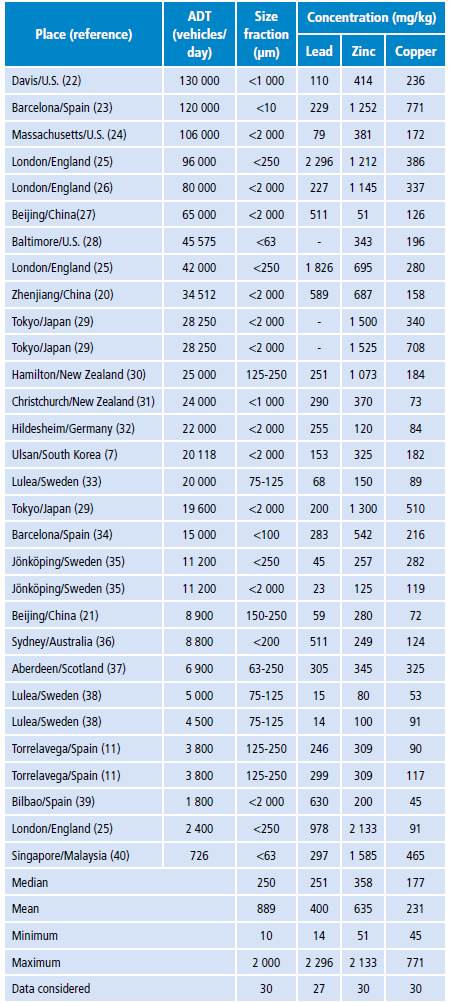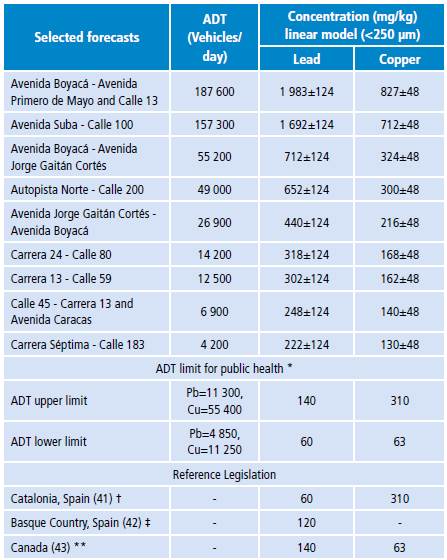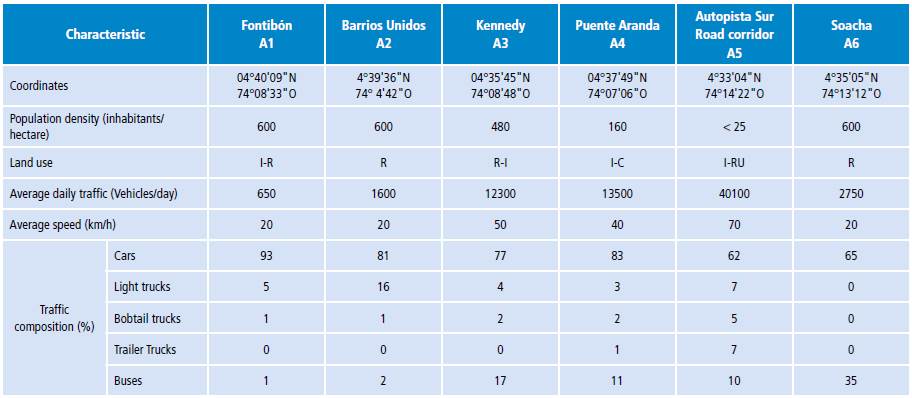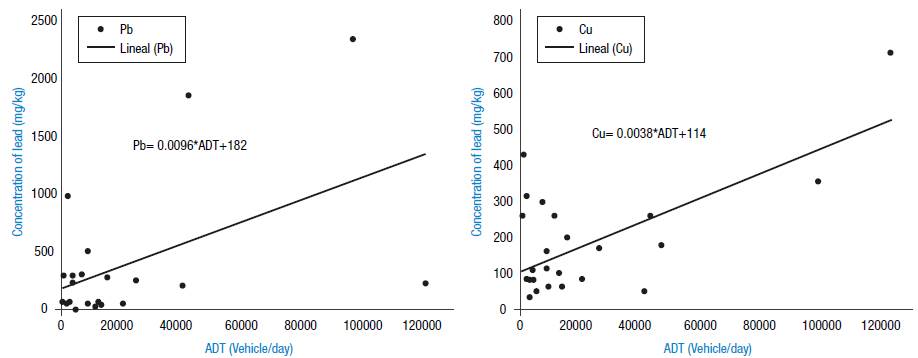Introduction
The density of vehicles used to transport passengers and consumer goods has increased significantly with the rapid growth of urban areas. 1,2 Vehicular traffic in these areas is one of the major sources of soil contamination, as the terrain near the roads is a drain for pollution from vehicles that could easily come into direct contact or by suspension with pedestrians and residents of surrounding areas. 3 In addition, vehicular traffic emits a wide range of hazardous pollutants, including heavy metals. 4,5 With this in mind, a deep understanding of the pollutants generated by vehicular traffic is relevant due to their harmful effects on public health. Moreover, studying the correlation between traffic intensity and heavy metal concentration in road sediments would allow the formulation of strategies to reduce the impact on urban public health.
Respiratory diseases such as asthma and lung cancer are associated with intense vehicular traffic in urban areas. 6,7 Atmospheric aerosols and sediments deposited on the surface of urban soil have increased with population concentration, leading to increased levels of pollution along road corridors. 1 Road sediments, on the other hand, are a potentially toxic medium since they contain heavy metals and hydrocarbons originating from a wide variety of sources of diffuse pollution, including dry and wet atmospheric deposition (rain), vehicle exhaust systems and parts (brake pads, tire wear and oil leaks), pavement wear, road demarcation paint, accidents, abrasion of construction materials and soil erosion. 8-10 Thus, road sediment has often been used as an indicator of heavy metal pollution in urban environments. 7,10,11
Chen et al.3 and McKenzie & Irwin 12 reported that the deposition of heavy metals on road surfaces was proportional to traffic intensity (vehicles/day). In this regard, Bannerman et al.13 and Zafra et al.14 observed that the amount of lead, zinc and copper present in runoff and road sediment could be related to the intensity of vehicular traffic. However, Barrett et al.15 suggested that traffic intensity was only significant at the local scale (road neighborhood) and that the variation of metal concentration was attributable to other factors such as emissions from industrial sources at a large scale (regional).
This research was developed in Bogotá, a megacity of Latin America (8.85 million inhabitants in 2015) recognized as the most densely populated urban center (26 000 inhabitants/km2) and the third city with the worst air pollution in the region. 16,17 There are few studies worldwide aimed at assessing the correlation between vehicular traffic and heavy metal content in urban sediments in developing countries, thus leading to the interest in developing this research.
The objective of this article is to present an analysis of the correlation between vehicular traffic intensity and heavy metal concentrations in sediments accumulated during the dry season on Bogotá road corridors. Furthermore, the city's heavy metal concentrations and traffic intensities are compared and analyzed with those reported internationally by similar investigations. Linear regression models were developed to predict and evaluate the degree of pollution in road surfaces with respect to reference legislation for the protection of human health in urban soil. This study is based on the three heavy metals most reported by research on road sediments: lead, zinc and copper. 18
Materials and methods
Research sites
The research sites were located in the megacity of Bogotá, central Colombia (Table 1), on road surfaces in the towns of Fontibón (A1), Barrios Unidos (A2), Kennedy (A3), Puente Aranda (A4), the Southern Highway road corridor or Autopista Sur (A5), and the Soacha conurbation (A6). In addition, nine road surfaces with traffic intensities between 4 200 and 187 600 vehicles per day were used for forecasting the concentration of heavy metals in road sediments in Bogotá: Avenida Boyacá between Avenida Primero de Mayo and Calle 13; Avenida Suba with Calle 100; Avenida Boyacá with avenida Jorge Gaitán Cortés; Autopista Norte with Calle 200; Avenida Jorge Gaitán Cortés with Avenida Boyacá; Carrera 24 with Calle 80; Carrera 13 with Calle 59; Calle 45 between Carrera 13 and Avenida Caracas; and Carrera Séptima with Calle 183. Information on traffic intensity was provided by the District Department of Transportation of Bogotá D.C.
Ethical considerations
The information collection and analysis systems used in this study had no effect on human or animal dignity and had no impact on the environment. The information was used for academic purposes only. This study was ethically endorsed by the Centro de Investigación y Desarrollo Científico of the Universidad Distrital Francisco José de Caldas through Minutes 030 of November 24, 2009.
Collection of road sediment
This was a descriptive observational study. Road sediment samples were taken in dry weather, at one side of the curb (0.50m), at the same time for one year (between 8 May 2010 and 8 May 2011) in A1, A2, A3 and A4, and for 127 days (between 7 January 2010 and 14 May 2010) in A5 and A6. The mean sampling frequency was 10 days for A1, A2, A3 and A4, and 3 days for A5 and A6. However, there were slight variations in sampling frequency due to the occurrence of precipitations that prevented the collection of sediment in dry weather.
The sampling area was 0.49m2 (0.70m x 0.70m) and the dimensions of the road sediment collection area were guaranteed by placing on the surface a wooden frame with the same dimensions of the sampling area. The sampling site was controlled to avoid repetition and to be close to previous sediment collection points. A plastic fiber brush and a handheld dustpan were used for the collection of the sediment. The number of samples collected in each research area was 36 for A1, A2, A3 and A4, and 43 for A5 and A6. A total of230 road sediment samples were collected.
Heavy metal concentration
The granulometry of the road sediment (<63-250μm) was determined using the ISO-11277 method. 19 The analysis of heavy metal concentration in the road sediment was performed for the size fraction <250μΓη because research has reported that this fraction is dominant in weight and has the tendency to record the highest concentrations of heavy metals in road sediments. 14,20,21
Heavy metal concentration in the road sediment was determined by flame atomic absorption spectrometry (ISO-11047 method). 19 The sediment samples were previously digested in a mixture of hydrochloric acid and nitric acid (3:1, aqua regia), method ISO-11466. 19 The heavy metals analyzed were lead, zinc and copper.
Statistical analysis
In order to identify the possible correlation between the variables of the global matrix developed for traffic intensity and heavy metal content in road sediments (literature review), a cluster analysis was applied using the software SPSS version 22.0. Data (variables) were standardized by means of z-scores prior to cluster analysis, and Euclidean distances of similarity between variables were calculated. A hierarchical analysis using Ward's method was then applied to the standardized data. The normal distribution of the data was determined using the Shapiro-Wilk test, while descriptive statistics and r-Pearson were used to deepen the analysis between variables. Finally, mathematical models were developed using linear regression to predict heavy metal concentrations on Bogota roads.
Results
Heavy metal concentration
Table 2 presents a review of the international literature 22-40 on heavy metal concentrations associated with road sediment for different traffic intensities between 1980 and 2015. A cluster analysis allowed the identification of four clusters: 1) zinc and copper concentrations, 2) lead concentration, 3) traffic density, and 4) fraction of size analyzed. Clusters 1, 2 and 3 were grouped at a higher level, perhaps implying a correlation between them. Similarly, a probable correlation between cluster 4 and clusters 1 and 2 was observed. The following are the results of the correlations suggested by the cluster test.
Table 2 International literature review on heavy metal concentration in road sediments (collected in dry weather) from different traffic intensities.

ADT: average daily traffic.
Source: Own elaboration.
A Pearson's correlation coefficient analysis was performed in order to evaluate the affinity in the origin of the heavy metals reported in Table 2, for example, the source of contamination. The results worldwide showed that there was a significant positive correlation -average to considerable- between zinc and copper concentrations associated with road sediment (r-Pearson=0.63, p<0.00 i ). In Bogotá, the correlation between these two metals was similar (r-Pearson =0.67, p<0.001 ). With respect to lead, positive correlations -between weak and average- were observed at both the international and national levels (r-Pearson= lead and copper: 0.16, p=0.044; lead and zinc: 0.38, p=0.025), and the local level (r-Pearson= lead and copper: 0.26, pO.001; lead and zinc: 0.50, p<0.001).
The results showed that the concentrations in the road sediment had the following sequence at the international level: zinc (358 mg/kg), lead (251 mg/kg) and copper (177 mg/kg) (Table 2). At the local level the sequence was: zinc (136 mg/kg), copper (81 mg/kg) and lead (72 mg/kg) (Table 3). Analyses of heavy metal concentrations in Bogotá focused on the size fraction <250μm of the road sediment because this was the dominant trend at the international level, as shown in Table 2.
Table 3 Heavy metal concentration in road sediments for different traffic intensities.

ADT: average daily traffic.
Source: Own elaboration.
International results showed no significant correlations between traffic intensity and lead and zinc concentrations in road sediments (size fraction <2 ΟΟΟμm) (Table 2). However, a positive -from weak to average- linear correlation was observed with copper concentration (r-Pearson=0.39, p=0.0i6). A similar analysis was performed taking into account only the size fraction <250μm of the road sediment. The results showed no significant correlation for zinc. However, at the international level, a positive linear correlation from weak to average between the average daily traffic intensity (ADT = vehicles/day) and concentrations (mg/kg of dry matter) of lead(r-Pearson=0.48, p=0.029, gl=16, Pb=0.0084* ADT+246) was observed. For copper, the results showed a linear correlation between average and strong (r-Pearson=0.73, p<0.00f, gl=17, Cu=0.0040*TPD+128). Figure 1 presents the linear models developed for lead and copper based on the information reported worldwide (Table 2) and in Bogotá (Table 3). Geometric and logarithmic models were also tested; however, the linear model showed a better fit (r-Pearson≥0.50).
Forecasts for Bogotá
Based on the linear models obtained, the concentration of metals (lead and copper) was predicted on nine road surfaces of Bogotá, with ADT between 4 200 and f 87 600 vehicles/day (Table 4). The results showed that lead and copper concentrations in the sediment of the road with the maximum ADT (Avenida Boyacá between Avenida Primero de Mayo and Calle 13) could reach figures of up to f 93 8 mg/kg and 827 mg/kg, respectively. The maximum figures reported internationally were 2 296 mg/kg for lead and 771 mg/kg for copper (ADT between 96 000-120 000 vehicles/day). In contrast, the predictions for the road with lower ADT (Carrera Séptima with Calle 183) allowed observing lead concentrations of 222 mg/kg and copper concentrations of 130mg/kg. International reports on roads with similar ADT (3 8004 500 vehicles/day) showed lead concentrations of 14-299 mg/kg and copper levels of 90-117 mg/kg (Table 2).
Table 4 Forecasts for heavy metal concentration in Bogotá with respect to reference legislative limits.

ADT: average daily traffic per flow fluctuation by direction, excluding motorcycles.
* Forecasts with linear models that integrated Bogotá and international information.
† Limits for the protection of human health: urban soil.
‡ Urban ground and children's play area.
** Residential land and parks.
Source: Own elaboration.
A comparative analysis of the forecasts based on reference legislation on inhalation, ingestion and dermal contact with contaminated soil (41-43) showed that all the selected roads exceeded the more flexible limit for lead (Canada, 140mg/kg). The ADT of all roads under evaluation were >4 200 vehicles/day (Table 4). On the other hand, only three of the nine selected road surfaces exceeded the most flexible limit for copper (Catalonia, 310 mg/kg). The roads that exceeded this limit had an ADT >55 200 vehicles/day.
Two new linear models were developed with origins in heavy metal concentration and ADT equal to zero, integrating the international (Table 2) and local (Table 3) reports. This sought to forecast the ADT associated with the limits established by the reference legislation for lead and copper. (41-43)
The following models were obtained: Pb=0.0124*ADT (r-Pearson=0.43, p<0.001, gl=22) and Cu=0.0056*ADT (r-Pearson=0.63, p<0.001, gl=23). The results for lead showed that ADT associated with the most stringent (Catalonia, 60 mg/kg) and more flexible (Canada, 140 mg/kg) legislative limits were 4 850 and 11 300 vehicles/day, respectively. With respect to copper, the ADT associated with the most stringent (Canada, 63mg/kg) and most flexible (Catalonia, 310mg/kg) legislative limits were 11 250 and 55 400 vehicles/day, respectively (Table 4). The results showed that lead was the most critical heavy metal when increasing the ADT of the roads under study. Finally, the limit ADT for public health for lead was lower or more restrictive than those for copper.
Discussion
Heavy metal concentration
The results suggest the existence of a common or dominant source for zinc and copper in Bogotá's road sediments, probably vehicular traffic. This is supported by an average to considerable correlation between the concentrations of these two heavy metals (r-Pearson=0.67). In contrast, various sources of pollution are suggested for lead (r-Pearson= lead and copper: 0.26, lead and zinc: 0.50) such as vehicle exhaust gas, road paint, pavement wear, traffic accidents, urban furniture and industrial emissions. (11,20,33) On average, the most abundant metal in the road corridors under study is zinc (Table 3). The order of presentation of heavy metal concentrations in Bogotá is zinc (96-334 mg/kg), copper (41-279 mg/kg) and lead (48-217 mg/kg). A similar trend is reported worldwide (Table 2).
At the international level, the determination of heavy metal concentration in the road sediments focuses on the size fraction <250μm. Studies suggest that this fraction is representative to analyze the correlation between traffic intensity and heavy metal concentration in road sediments (Table 2). The results show that the correlation between traffic intensity and concentrations of lead and copper in road sediments is more evident for the size fraction <250μm rather than for the fraction <2 000μm.
Particles emitted from lead and copper sources in the road environment may be associated with sizes <250μm. Ball et al. (36) report a similar behavior for heavy metals (lead, zinc, copper, chromium and iron) in the finer fraction of road sediment.
Forecasts regarding reference legislation
The linear model has the best fit to represent the correlation between traffic intensity and the concentrations of lead and copper in road sediments (r-Pearson≥0.50). However, zinc concentrations do not show a significant correlation with traffic intensity in the road corridors under study. Forecasts with the linear model developed for lead concentrations in road sediments suggest that the nine roads selected in Bogotá exceed the most flexible legislative reference limit (Canada, Pb=140mg/kg in residential land and parks). In the case of copper, forecasts show that three of the nine routes selected exceed the most flexible legislative limit (Catalonia, Cu=310mg/kg on urban land). The selected roads recorded an ADT >4 200 vehicles/day. Therefore, these results suggest lead as the heavy metal of greatest public health concern in the Bogotá road corridors; on average, the concentrations of this metal in the road sediments exceed between 1.59 and 14.2 times the most flexible legislative reference limit (Table 4).
Conclusions
The findings of this research are a reference for the development and implementation of strategies for the control of heavy metal pollution in urban roads. In this regard, the following ADT for public health limits are proposed for decision-making on lead contamination control on urban roads in Bogotá: lower public health limit of4 850 vehicles/day and upper public health limit of 11 300 vehicles/day.

















